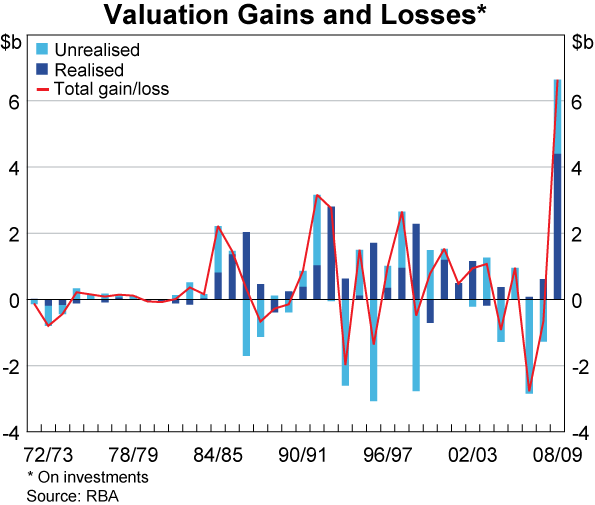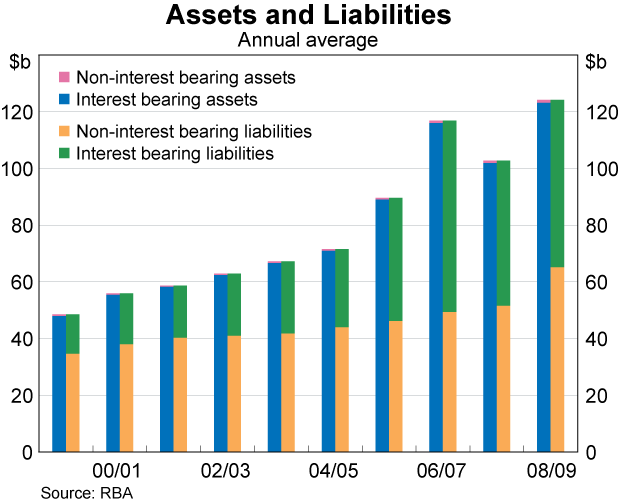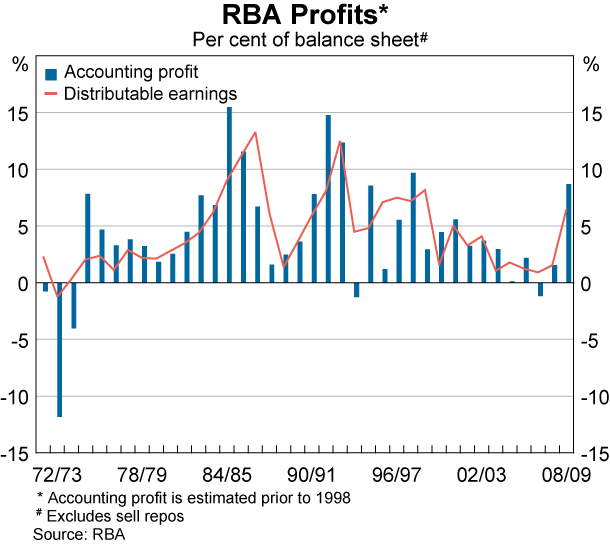Reserve Bank of Australia Annual Report – 2009 Earnings and Distribution
The Reserve Bank holds assets primarily to conduct operations in financial markets in pursuit of its central banking objectives. These operations centre on implementing monetary policy in Australia, supporting the Bank's role in the foreign exchange market and in managing Australia's international reserves. Although these activities are carried out for policy purposes, they are profitable in most years.
The Reserve Bank's profits have two components – underlying earnings and valuation gains (or losses) – that reflect the structure of its balance sheet and its operations. Underlying earnings are determined by interest earnings on financial assets held as Australia's foreign exchange reserves or as the portfolio of domestic securities that underpins daily liquidity management operations. Total assets stood at $103 billion at end-June 2009. While these assets earn market rates of interest, no interest is paid on a significant proportion of the Bank's liabilities, namely banknotes and capital and reserves. Net interest receipts are augmented by relatively small sums from fees the Bank earns from the banking and payments services it provides and from rental income. Operating costs reduce underlying earnings.
As the Reserve Bank's financial assets are mainly held as securities, valuation gains and losses can also be large. The value of this portfolio of assets is sensitive to movements both in market interest rates and exchange rates: a fall in market yields causes prices of securities to rise and, therefore, results in valuation gains; a rise in yields leads to valuation losses. Likewise, a depreciation of the exchange rate results in valuation gains as foreign securities are worth more in terms of Australian dollars at the lower exchange rate; an exchange rate appreciation results in valuation losses. The Bank is constrained in managing the market risks associated with fluctuations in asset values, since, as noted, these assets are held in support of central banking activities. Consequently, the impact on the Bank's profits of movements in the exchange rate and market yields can be large and volatile.
The extent to which gains are realised depends on the operations the Reserve Bank undertakes in financial markets. Gains and losses are realised only when the Bank sells assets; they otherwise remain unrealised. The fall in the exchange rate and in bond yields around the world late in 2008 saw the Bank record large valuation gains, contrasting with the valuation losses of the preceding couple of years when the exchange rate had appreciated. These valuation gains were realised to a significant extent because the Bank sold foreign exchange as the value of Australian dollar moved towards its low point around October, and on the sale of foreign securities at lower yields than they had been purchased.

The measures the Reserve Bank adopted in response to the global financial crisis resulted in a large, but mostly temporary, expansion in the balance sheet and increased earnings slightly in 2008/09. The term deposit facility for domestic financial institutions was required for a relatively short period and was in any case associated with only a thin interest margin; the US dollar swap facility established with the Federal Reserve had, by design, no effect on profits; and the expanded range of acceptable collateral eligible for domestic operations had no impact either on balance sheet footings or on earnings; the main impact on earnings came from extending the term of the Bank's domestic repurchase agreements. The small effect on profits of these innovations was, of course, incidental, as these steps were intended exclusively to support the Bank's policy objectives. Discussion of management of the Bank's balance sheet, and of these new facilities, is contained in the chapter on ‘Operations in Financial Markets’.
The Reserve Bank reports accounting profit as earnings from all sources – underlying earnings, and realised and unrealised gains – in accordance with Australian equivalents to International Financial Reporting Standards (AIFRS). The distribution of profits – essentially determination of the dividend payable to the Australian Government, the Bank's owner – is governed by section 30 of the Reserve Bank Act 1959. In effect, this legislation determines that underlying earnings and realised gains are to be made available for distribution; unrealised gains are retained and transferred to the Unrealised Profits Reserve. These provisions also determine the process for approving transfers to the Reserve Bank Reserve Fund, the Bank's permanent reserve of capital. After consultation with the Board, the Treasurer has approved such a transfer from earnings in 2008/09.
Earnings Available for Distribution
Underlying earnings amounted to $2,150 million in 2008/09, about $80 million more than the previous year. While interest rates on the Reserve Bank's investments declined over the course of 2008/09 in line with policy and market interest rates around the world, net interest income was boosted by a rise in the average level of its interest-earning assets, funded by interest-free liabilities, in particular notes on issue and capital (including reserves). The lower exchange rate in 2008/09 than in the previous year also boosted the Australian-dollar value of interest earnings on foreign securities.

Gains of $4,404 million were realised in 2008/09, resulting from sales of foreign exchange and securities as the exchange rate and interest rates were, on the whole, lower during the year. In particular:
- Gains on foreign exchange amounted to $2,943 million from sales of foreign currency associated with operations to manage international reserves and intervene in the foreign exchange market. Large unrealised gains recorded in the middle of the financial year were partly unwound as the exchange rate rose later in 2008/09.
- Gains of $1,355 million were realised on the sale of foreign securities acquired when market yields were higher as the Bank sold lines of stock of diminishing liquidity to re-invest in benchmark bonds in the normal course of managing the foreign portfolio. Gains were also realised in transactions to re-align the portfolio of international reserves to the shortened benchmark position.
- Gains of $106 million were realised on the sale of domestic securities.


Taking account of underlying earnings and realised gains, earnings available for distribution in 2008/09, at $6,554 million, were larger than in any previous year and $5,151 million higher than the equivalent figure in 2007/08. In addition, total unrealised valuation gains of $2,252 million were transferred to the Unrealised Profits Reserve.
| Underlying earnings |
Realised gains and losses |
Unrealised losses charged to other sources of income |
Earnings available for distribution |
|
|---|---|---|---|---|
| 1986/87 | 1,412 | 2,035 | – | 3,447 |
| 1987/88 | 1,062 | 464 | – | 1,526 |
| 1988/89 | 891 | −494 | −80 | 417 |
| 1989/90 | 1,049 | 245 | −199 | 1,095 |
| 1990/91 | 1,322 | 391 | – | 1,713 |
| 1991/92 | 1,516 | 1,038 | – | 2,554 |
| 1992/93 | 1,760 | 2,803 | – | 4,563 |
| 1993/94 | 1,556 | 628 | −676 | 1,508 |
| 1994/95 | 1,649 | 123 | – | 1,772 |
| 1995/96 | 1,784 | 1, 712 | −1,010 | 2,486 |
| 1996/97 | 1,715 | 1,990 | – | 3,705 |
| 1997/98 | 1,750 | 1,524 | – | 3,274 |
| 1998/99 | 1,816 | 2,284 | −424 | 3,676 |
| 1999/00 | 1,511 | −708 | – | 803 |
| 2000/01 | 1,629 | 1,205 | – | 2,834 |
| 2001/02 | 1,400 | 489 | – | 1,889 |
| 2002/03 | 1,238 | 1,159 | – | 2,397 |
| 2003/04 | 882 | −188 | – | 694 |
| 2004/05 | 997 | 366 | – | 1,363 |
| 2005/06 | 1,156 | 21 | – | 1,177 |
| 2006/07 | 1,381 | 75 | −371 | 1,085 |
| 2007/08 | 2,068 | 614 | −1,279 | 1,403 |
| 2008/09 | 2,150 | 4,404 | – | 6,554 |
Reserves and Dividend
As with other financial institutions, it is desirable for central banks to hold capital to provide capacity to absorb losses. The Reserve Bank Reserve Fund (RBRF) is established by the Reserve Bank Act as a permanent general reserve. Balances in this reserve are regarded as being available to cover extraordinary losses from a range of risks, especially from exceptionally large falls in the market value of the Reserve Bank's assets that cannot be absorbed by its other resources. In other words, the RBRF is essentially the Bank's capital and it has been funded over time by transfers from earnings available for distribution. Under section 30 of the Reserve Bank Act, transfers to the RBRF from distributable earnings are determined by the Treasurer, after consultation with the Board.
The Board reviews the adequacy of capital against the market risk associated with the Reserve Bank's financial assets, after taking account of the extent to which these risks are hedged by liabilities. In considering the position over 2008/09, the Board concluded that a transfer to the RBRF would be consistent with its longstanding policy in relation to this fund; the transfer does not reflect any heightened concern about the credit quality either of the Bank's assets or the expanded range of collateral it holds. The Treasurer agreed that a sum of $577 million would be placed to the credit of the RBRF from earnings available for distribution in 2008/09, lifting the balance in this reserve to $6,863 million.
The balance of distributable earnings after any transfer to the RBRF is payable as a dividend to the Australian Government. Accordingly, the dividend payable in 2009/10 amounts to $5,977 million. This dividend is usually paid early in the financial year following the year in which profits are earned. As on numerous past occasions, the Treasurer has decided to defer part of the dividend payable until 2010/11. In particular, a total of $5,227 million was paid to the Australian Government in August 2009 and a further sum of $750 million will be paid in 2010/11. Details are shown in the table below.
| Earnings available for distribution |
Transfers to reserves |
Payments to the Australian Government | |||||||
|---|---|---|---|---|---|---|---|---|---|
| Balance available from current year's profit |
Interim payment from current year's profit |
Payment from previous year's profit |
Payment delayed from previous year |
Total payment |
|||||
| 1990/91 | 1,713 | 210 | 1,503 | 400 | 275 | – | 675 | ||
| 1991/92 | 2,554 | 200 | 2,354 | 400 | 1,103 | – | 1,503 | ||
| 1992/93 | 4,563 | 750 | 3,813 | 600 | 1,954 | – | 2,554 | ||
| 1993/94 | 1,508 | – | 1,508 | – | 3,213 | – | 3,213 | ||
| 1994/95 | 1,772 | – | 1,772 | 200 | 1,508 | – | 1,708 | ||
| 1995/96 | 2,486 | 150 | 2,336 | 200 | 1,572 | – | 1,772 | ||
| 1996/97 | 3,705 | 2,005 | 1,700 | – | 2,136 | – | 2,136 | ||
| 1997/98 | 3,274 | 548 | 2,726 | – | 1,700 | – | 1,700 | ||
| 1998/99 | 3,676 | – | 3,676 | – | 2,726 | – | 2,726 | ||
| 1999/00 | 803 | – | 803 | – | 3,000 | – | 3,000 | ||
| 2000/01 | 2,834 | – | 2,834 | – | 803 | 676 | 1,479 | ||
| 2001/02 | 1,889 | – | 1,889 | – | 2,834 | – | 2,834 | ||
| 2002/03 | 2,397 | 133 | 2,264 | – | 1,889 | – | 1,889 | ||
| 2003/04 | 694 | – | 694 | – | 1,300 | – | 1,300 | ||
| 2004/05 | 1,363 | – | 1,363 | – | 374 | 964 | 1,338 | ||
| 2005/06 | 1,177 | – | 1,177 | – | 1,063 | 320 | 1,383 | ||
| 2006/07 | 1,085 | – | 1,085 | – | 1,177 | 300 | 1,477 | ||
| 2007/08 | 1,403 | – | 1,403 | – | 1,085 | – | 1,085 | ||
| 2008/09 | 6,554 | 577 | 5,977 | – | 1,403 | – | 1,403 | ||
| 2009/10 | – | – | – | – | 5,227 | – | 5,227 | ||
| 2010/11 | – | – | – | – | – | 750 | – | ||
In addition to the RBRF, the Reserve Bank maintains a number of other financial reserves. As noted, unrealised gains are transferred to the Unrealised Profits Reserve, to absorb future valuation losses or to be realised when relevant assets are sold. In 2008/09, unrealised gains of $2,252 million were transferred to this reserve. The approach, determined by legislation, in which the Bank retains unrealised gains is based on sound central banking practice, since distribution of such gains would erode the capacity to cope with subsequent unrealised losses, which, in the case of the Reserve Bank, are unavoidable in some years for the reasons explained above.
In addition to items that affect the Reserve Bank's profit and loss account, revaluation gains and losses on non-traded assets – such as gold holdings, shares in the BIS and property, plant and equipment – are reflected in asset revaluation reserves. The balance of these reserves represents the difference between the market value of these assets and the cost at which they were acquired. The balance in these reserves at 30 June 2009 stood at $3,308 million, an increase of $501 million, mainly reflecting an increase in the Australian dollar value of the Bank's holdings of gold, offset to a small extent by a fall in the value of its properties.
Accounting Profits
The Reserve Bank's financial statements (and accompanying Notes to the Accounts) are prepared in accordance with AIFRS, consistent with the Finance Minister's Orders issued under the Commonwealth Authorities and Companies Act 1997. Under these standards, accounting profit, as noted, is measured as profit from all sources, including unrealised gains and losses.
Accounting profit in 2008/09 was $8,806 million, compared with an accounting profit of $1,430 million the previous year.
